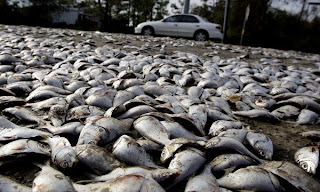Menhaden, Mossbunkers, Pogies, Bunker -- All Dead

I mentioned the other day that there had been bunker (or mossbunker) die-offs in a couple of places in the area this summer, including Narragansett Bay, but "a couple" is an understatement. John Torgan, the Narragansett Baykeeper, says on his blog that there were bunker kills ... ... in Providence, East Providence, Barrington, Wickford, Warren, Cranston, the Kickemuit River, and in Massachusetts' tributaries to Mount Hope Bay.
But why? Here's what he says:
Like the Greenwich Bay fish kill of 2003, warm temperatures, algae blooms and low oxygen combined to suffocate fish in the shallow and restricted coves of the upper and mid-Bay.
Unlike 2003, where an estimated million juvenile menhaden died along with millions of clams and a much smaller number of flounder,crabs and other fish, 2008's fish kills involve exclusively adult menhaden.
And while oxygen levels are low and temperatures are high right now in late August, they're not off the charts. Today I did a water quality survey in the Seekonk and Providence Rivers and Upper Bay and we found water temperatures in the high 60's to low 70's Fahrenheit, and oxygen levels near the lower limit of healthy but not anoxic. (See the data on Brown University Geo-Science's website here: http://www.geo.brown.edu/georesearch/insomniacs/ )
This year, adult menhaden are much more abundant in the Bay than at any time in the last 30 years, and these die-offs may be an effect of that big population, in part. For every dead one we see, hundreds swirl in cooler deeper water a few yards away.
In my previous post I noted that there are historical records of bunker kills in the northeast -- specifically on Staten Island -- from the 1600s and the 1800s (and those are merely the ones I've come across). So does that mean they are a normal occurrence? Perhaps -- especially if you assume that the examples I cited were two among many that were either unrecorded or that I hadn't heard about. Here's what Torgan says:
Some suggest that this die-off phenomena is normal and natural, and that bluefish and other predators chase these fish into the coves where they become exhausted and succumb to the relatively warmer, more turbid and lower-oxygen water of the coves. Stress and oxygen starvation certainly appear to be part of the problem.
But maybe Jasper Danckaerts and Henry David Thoreau wrote down what they saw precisely because it was abnormal? Historically, perhaps, bunker kills were rare. That might mean that they happen more frequently now because something is adding to the natural stress. Here's what Torgan speculates:
But is it really normal and natural? Adult menhaden like these are strong swimmers- it would seem that they should be able to swim back out to cooler cleaner water. And it's a fact that many of these coves are seriously polluted with sewage and stormwater, and that this pollution contributes to the degraded conditions in which the fish are dying. Sam Wells, a transplanted Long Island Sounder now living on a barrier beach in Texas, wrote to tell me this: I don’t know if we’re talking the same fish ..., but down here they’re called menhaden or “pogies.” The travel in immense schools and have been used in farming for decades – and Lord do they stink to high heaven! I’ve attached a photo from Hurricane Ike [above] that shows a pogie kill, these ones thrown up on the shore about 15 miles inland near Orange, Texas. The must have came in on the surge waters. Ain’t that something?
Labels: bunker, menhaden, mossbunker, pogies



